Garmin 02050 LOW POWER TRANSMITTER (2400-2483.5 MHz) User Manual 1
Garmin International Inc LOW POWER TRANSMITTER (2400-2483.5 MHz) Users Manual 1
Garmin >
Contents
- 1. Users Manual 1
- 2. Users Manual 2
Users Manual 1
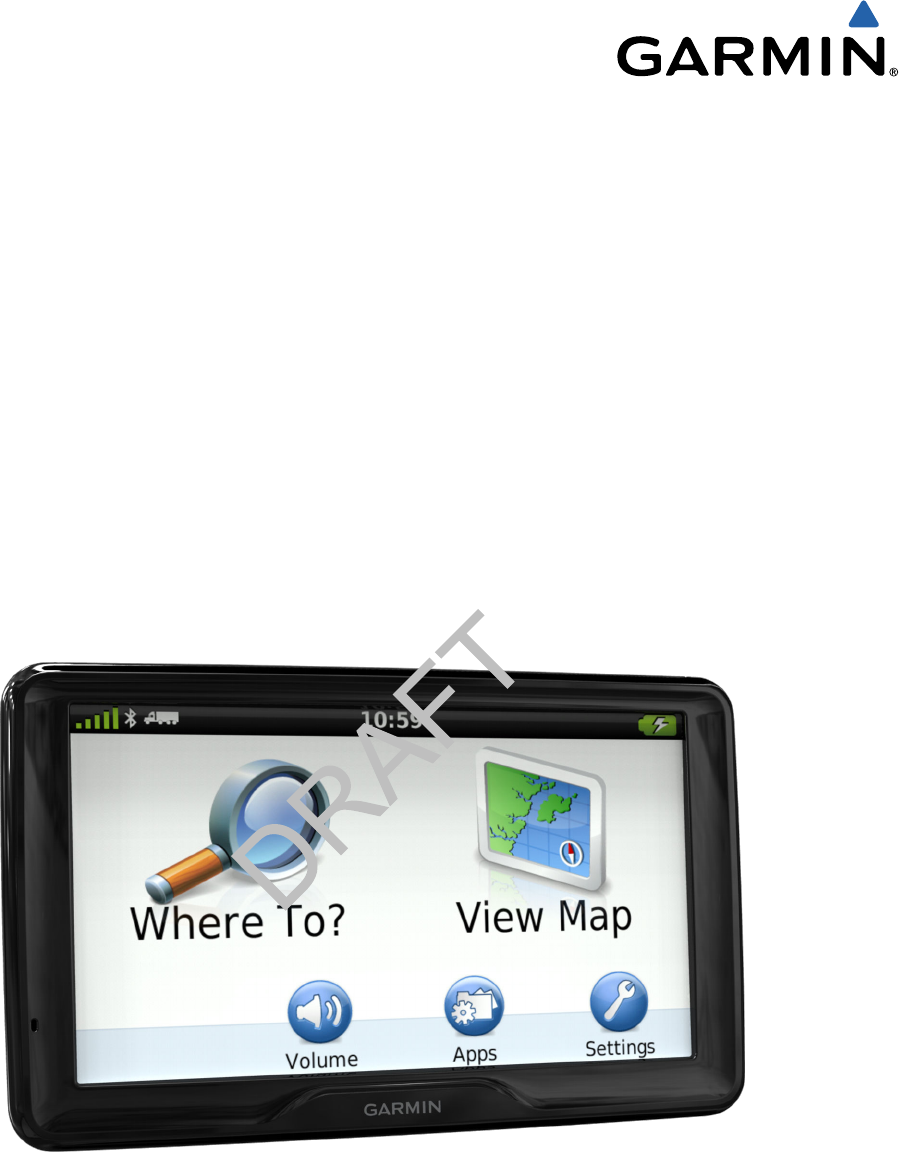
dēzl 760
Owner’s Manual
October 2012 190-01511-00 Printed in Taiwan

All rights reserved. Under the copyright laws, this manual may not be copied, in whole or in part, without the written consent of Garmin. Garmin reserves the
right to change or improve its products and to make changes in the content of this manual without obligation to notify any person or organization of such
changes or improvements. Go to www.garmin.com for current updates and supplemental information concerning the use of this product.
, the Garmin logo, and dēzl™ are trademarks of Garmin Ltd. or its subsidiaries, registered in the USA and other countries. , ecoRoute™ HomePort™, , ,
nüMaps Guarantee™, nüMaps Lifetime™, and trafficTrends™ are trademarks of Garmin Ltd. or its subsidiaries. These trademarks may not be used without the
express permission of Garmin.
The word mark and logos are owned by the Bluetooth SIG, Inc., and any use of such name by Garmin is under license. is a trademark of SD-3C. and are
registered trademarks of Microsoft Corporation in the United States and/or other countries. is a trademark of Apple Computer, Inc.
HD Radio Technology manufactured under license from iBiquity Digital Corporation. U.S. and Foreign Patents. and the HD logo are proprietary trademarks of
iBiquity Digital Corporation.

Table of Contents
Getting Started............................................................... 1
Connecting the Device to Vehicle Power................................... 1
About myDashboard.................................................................. 1
Setting Up myDashboard...................................................... 1
Registering the Device.......................................................... 1
Updating the Software........................................................... 1
nüMaps Guarantee™............................................................ 1
Lifetime Subscriptions................................................................ 1
Activating Lifetime Maps....................................................... 1
Turning Off the Device............................................................... 1
Resetting the Device............................................................. 1
About Sleep Mode..................................................................... 1
Entering Sleep Mode............................................................. 1
Exiting Sleep Mode............................................................... 1
Adjusting the Screen Brightness................................................ 1
Adjusting the Volume................................................................. 1
Status Bar Icons......................................................................... 1
Acquiring GPS Signals.......................................................... 2
Transportation Modes........................................................... 2
Battery Information................................................................ 2
Setting the Time.................................................................... 2
Using the On-Screen Buttons.................................................... 2
Using the On-Screen Keyboard................................................. 2
About Shortcuts......................................................................... 2
Adding a Shortcut Icon.......................................................... 2
Removing a Shortcut............................................................. 2
Entering a Truck or RV Profile................................................... 2
Finding Locations.......................................................... 2
About Locations......................................................................... 2
Finding a Location by Category............................................ 2
Finding Trucking Points of Interest........................................ 2
Finding a Location Using the Search Bar.............................. 3
Changing the Search Area.................................................... 3
Reporting a Closed or Missing Location............................... 3
Rating a Point of Interest....................................................... 3
About Search Tools................................................................... 3
Finding an Address............................................................... 3
Finding an Intersection.......................................................... 3
Finding a City........................................................................ 3
Finding a Location Using Coordinates.................................. 3
Finding a Location by Browsing the Map.............................. 3
Using a Breakdown Directory................................................ 3
Saving a Home Location............................................................ 3
Going Home.......................................................................... 4
Editing Your Home Location Information.............................. 4
Finding Recently Found Destinations........................................ 4
Clearing the List of Recently Found Locations...................... 4
Finding Parking.......................................................................... 4
Finding Your Last Parking Spot............................................ 4
Setting a Simulated Location..................................................... 4
Saving Locations........................................................................ 4
Saving a Location.................................................................. 4
Saving Your Current Location............................................... 4
Starting a Route to a Saved Location................................... 4
Editing a Saved Location...................................................... 4
Assigning Categories to a Saved Location........................... 4
Sharing a Saved Location..................................................... 4
Sending a Location to the Device......................................... 4
Deleting a Saved Location.................................................... 4
Navigation.......................................................................5
Starting a Route......................................................................... 5
Changing the Route Calculation Mode................................. 5
Previewing Multiple Routes................................................... 5
Starting a Route to a Saved Location................................... 5
Your Route on the Map.............................................................. 5
Using the Navigation Map..................................................... 5
Adding a Point to a Route..................................................... 5
Taking a Detour..................................................................... 5
Stopping the Route............................................................... 5
Using Suggested Routes...................................................... 5
About Exit Services.................................................................... 5
Finding Exit Services............................................................. 5
Navigating to an Exit............................................................. 5
Avoiding Road Features............................................................ 5
About Custom Avoidances......................................................... 5
Avoiding an Area................................................................... 5
Avoiding a Road.................................................................... 6
Disabling a Custom Avoidance............................................. 6
Deleting Custom Avoidances................................................ 6
Enabling Advanced Detours...................................................... 6
Taking a Detour Around Specified Areas.............................. 6
Navigating Off Road................................................................... 6
Map Pages...................................................................... 6
Customizing the Map................................................................. 6
Customizing the Map Layers................................................. 6
Viewing the Trip Log............................................................. 6
Changing the Map Data Field............................................... 6
Customizing Map Buttons..................................................... 6
Changing the Map Dashboard.............................................. 6
Changing the Map Perspective............................................. 6
Viewing Turns............................................................................ 6
Viewing a List of Turns.......................................................... 6
Viewing the Next Turn........................................................... 7
Viewing Junctions................................................................. 7
Viewing Traffic Alerts............................................................ 7
Viewing Trip Information....................................................... 7
About Active Lane Guidance................................................. 7
Viewing Current Location Information........................................ 7
Finding Nearby Services....................................................... 7
Getting Directions to Your Current Location......................... 7
Hands-Free Phone Calls................................................7
About Hands-Free Calling.......................................................... 7
Enabling Bluetooth Wireless Technology.............................. 7
Pairing Your Phone.................................................................... 7
Disconnecting Your Phone.................................................... 7
Tips After Pairing the Devices............................................... 7
Placing a Call............................................................................. 7
Dialing a Number.................................................................. 7
Calling a Contact in Your Phone Book.................................. 8
Calling a Location.................................................................. 8
Receiving a Call......................................................................... 8
Using the Call History................................................................ 8
Using In-Call Options................................................................. 8
Saving a Home Phone Number................................................. 8
Calling Home......................................................................... 8
Using the Apps...............................................................8
Using Help................................................................................. 8
Searching Help Topics.......................................................... 8
About Smartphone Link............................................................. 8
Downloading Smartphone Link............................................. 8
Connecting to Smartphone Link............................................ 8
Sending a Location from Your Phone to Your Device........... 8
Disabling Calls While Connected to Smartphone Link.......... 8
About Garmin Live Services...................................................... 8
Subscribing to Garmin Live Services.................................... 8
About ecoRoute......................................................................... 8
ecoRoute HD Accessory....................................................... 8
Setting Up the Vehicle........................................................... 8
Table of Contents i

Changing the Fuel Price........................................................ 8
About the ecoChallenge........................................................ 8
Viewing Fuel Economy Information....................................... 8
Mileage Reports.................................................................... 8
Resetting ecoRoute Information............................................ 8
Viewing myGarmin Message..................................................... 8
Viewing the Weather Forecast................................................... 8
Viewing Weather Near a Different City................................. 8
Viewing the Weather Radar.................................................. 8
Viewing Weather Alerts......................................................... 8
Checking Road Conditions.................................................... 9
Planning a Trip........................................................................... 9
Scheduling a Trip.................................................................. 9
Changing Transportation Modes in a Trip............................. 9
Navigating to a Saved Trip.................................................... 9
Editing a Saved Trip.............................................................. 9
Viewing Pictures........................................................................ 9
Viewing a Slideshow............................................................. 9
Setting a Picture as Wallpaper.............................................. 9
Deleting Pictures................................................................... 9
Viewing Previous Routes and Destinations............................... 9
Using the World Clock............................................................... 9
Viewing the World Map......................................................... 9
Setting an Alarm........................................................................ 9
Using the Calculator................................................................... 9
Converting Units........................................................................ 9
Setting Currency Conversion Rates...................................... 9
About Offers............................................................................. 10
Viewing Offers..................................................................... 10
Viewing an Offer List........................................................... 10
Disabling Traffic and Offers................................................. 10
Using the Language Guide...................................................... 10
Purchasing the Language Guide......................................... 10
Selecting Languages in the Language Guide..................... 10
Translating Words and Phrases.......................................... 10
Using a Bilingual Dictionary................................................ 10
About Traffic.................................................................10
Receiving Traffic Data.............................................................. 10
Traffic Receiver........................................................................ 10
About the Traffic Icon.......................................................... 11
Traffic on Your Route............................................................... 11
Viewing Traffic on Your Route............................................ 11
Manually Avoiding Traffic on Your Route............................ 11
Taking an Alternate Route.................................................. 11
Viewing Traffic on the Map.................................................. 11
Traffic in Your Area.................................................................. 11
Searching for Traffic Delays................................................ 11
Viewing a Traffic Incident on the Map................................. 11
Understanding Traffic Data...................................................... 11
Traffic Subscriptions................................................................ 11
Subscription Activation........................................................ 11
Disabling Traffic....................................................................... 11
Using Trucking Features............................................. 11
About IFTA Logging................................................................. 11
Entering Fuel Data.............................................................. 11
Using Fuel Logs.................................................................. 11
Viewing and Exporting a Jurisdiction Summary.................. 11
Using Trip Reports.............................................................. 11
Viewing Exported Jurisdiction Summaries and Trip
Reports................................................................................ 11
About Hours of Service............................................................ 11
Recording Your Duty Status................................................ 11
Using Driving Logs.............................................................. 11
About Drivers...................................................................... 11
Adding Shipments............................................................... 12
Exporting Driving Logs........................................................ 12
Data Management........................................................ 12
About Data Management......................................................... 12
File Types................................................................................ 12
About Memory Cards............................................................... 12
Installing a Memory Card.................................................... 12
Connecting the Device to Your Computer............................... 12
Transferring Data From Your Computer.................................. 12
Disconnecting the USB Cable............................................. 12
Deleting Files........................................................................... 12
Customizing the Device.............................................. 12
Adding Truck or RV Profiles..................................................... 12
Adding Truck or RV Profiles................................................ 12
Editing Truck or RV Profiles................................................ 12
Map and Vehicle Settings........................................................ 12
Enabling Maps.................................................................... 12
Navigation Settings.................................................................. 13
Route Preferences.............................................................. 13
Display Settings....................................................................... 13
Settings.................................................................................... 13
Disabling Bluetooth............................................................. 13
Traffic Settings......................................................................... 13
About Traffic Subscriptions................................................. 13
trafficTrends........................................................................ 13
Units and Time Settings........................................................... 13
Language and Keyboard Settings............................................ 13
Device and Privacy Settings.................................................... 13
Proximity Alerts Settings.......................................................... 13
Restoring Settings.................................................................... 14
Appendix.......................................................................14
Warning Icons.......................................................................... 14
Restriction Warnings........................................................... 14
Road Condition Warnings................................................... 14
Other Warnings................................................................... 14
Using a Backup Camera.......................................................... 14
Power Cables........................................................................... 14
Charging the Device............................................................ 14
About Device Care................................................................... 14
Cleaning the Outer Casing.................................................. 14
Cleaning the Touchscreen.................................................. 14
Avoiding Theft..................................................................... 14
Extending the Battery Life................................................... 14
Changing the Fuse in the Vehicle Power Cable...................... 14
Mounting on Your Dashboard.................................................. 14
Removing the Device, Cradle, and Mount............................... 14
Removing the Device from the Cradle................................ 14
Removing the Cradle from the Mount................................. 15
Removing the Suction Cup Mount from the Windshield...... 15
Purchasing Additional Maps.................................................... 15
Safety Cameras....................................................................... 15
Custom Points of Interest......................................................... 15
Installing POI Loader Software........................................... 15
Using the POI Loader Help Files......................................... 15
Finding Extras..................................................................... 15
Purchasing Accessories........................................................... 15
Troubleshooting....................................................................... 15
Index..............................................................................16
ii Table of Contents

Getting Started
WARNING
See the Important Safety and Product Information guide in the
product box for product warnings and other important
information.
1Mount the device ().
2Register the device (page 1).
3Check for updates:
• Software updates (page 1).
• Free map update (page 1).
Connecting the Device to Vehicle Power
WARNING
This product contains a lithium-ion battery. To prevent the
possibility of personal injury or product damage caused by
battery exposure to extreme heat, store the device out of direct
sunlight.
Before you use your device on battery power, you should
charge it.
1Plug the vehicle power cable into the USB port on the mount.
2Snap the mount onto the suction cup.
3Press the suction cup to the windshield, and flip the lever
back toward the windshield.
4Fit the bottom of your device into the mount.
5Tilt your device back until it snaps into place.
6Plug the other end of the vehicle power cable into a power
outlet in your vehicle.
7If necessary, connect the external antenna to the traffic
receiver and secure it to the windshield using the suction
cups.
About myDashboard
Use myDashboard to register your device, check for software
and map updates, access product manuals and support, and
more.
Setting Up myDashboard
1Connect the USB cable to the USB port on the back of the
device.
2Connect the USB cable to the USB port on your computer.
3Go to http://www.garmin.com/dashboard.
4Follow the on-screen instructions.
Registering the Device
1Open myDashboard (page 1).
2Click Register Now.
3Follow the on-screen instructions.
Updating the Software
1Open myDashboard (page 1).
2Under Software Updates, click Update Now.
3Follow the on-screen instructions.
nüMaps Guarantee™
To receive one free map update (if available), register your
device at http://my.garmin.com within 90 days of acquiring
satellites while driving with your device. You are not eligible for
the free map update if you register by phone or wait longer than
90 days after the first time you acquire satellites while driving
with your device. For more information, go to
http://www.garmin.com/numaps.
Updating Maps
1Open myDashboard (page 1).
2Register the device (page 1).
3Select an option:
• Under Map Updates, click Update Now.
• If a free map update is no longer available, click Buy
Now.
4Follow the on-screen instructions.
Lifetime Subscriptions
Some models include subscriptions to lifetime features.
LT : This model includes a lifetime traffic subscription and a
traffic receiver (automobile mode only).
LM : This model includes a nüMaps Lifetime™ subscription,
which provides quarterly map updates for the life of your
device. For terms and conditions go to
http://www.garmin.com/numapslifetime.
LMT : This model includes a nüMaps Lifetime subscription,
lifetime traffic subscription, and a traffic receiver (automobile
mode only).
Activating Lifetime Maps
DELETE THIS TEXT. Delete taskbody tags for a title-only topic.
Turning Off the Device
1Hold the Power key.
NOTE: If you hold the Power key for less than 5 seconds,
the device enters sleep mode (page 1).
2Select Off.
Resetting the Device
You can reset your device if it stops functioning.
Hold the Power key for 10 seconds.
About Sleep Mode
Use sleep mode to conserve battery power when your device is
not in use. Sleep mode uses very little power, and a battery
charge lasts for weeks when your device is in sleep mode.
Entering Sleep Mode
Press the Power key.
Exiting Sleep Mode
While the device is in sleep mode, press the Power key.
Adjusting the Screen Brightness
1Select Settings > Display > Brightness.
2Use the slider bar to adjust the brightness.
Adjusting the Volume
1Select Volume.
2Select an option:
• Use the slider bar to adjust the volume.
• Select to mute the device.
Status Bar Icons
The status bar is located at the top of the main menu. The
status bar icons display information about features on the
device. You can select some icons to change settings or view
additional information.
GPS signal status.
technology status (appears when is enabled).
Transportation mode indicator.
Getting Started 1
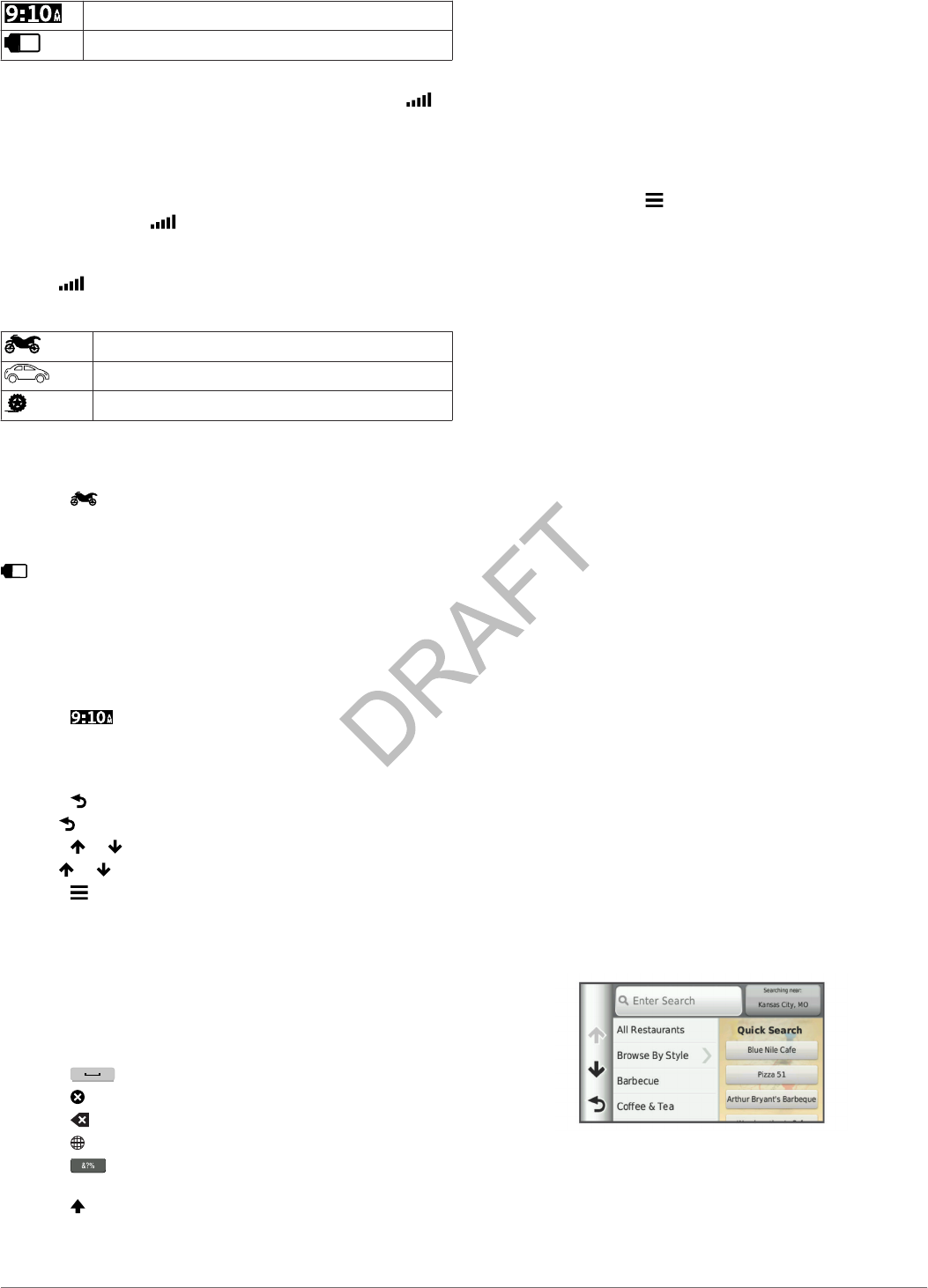
Current time.
Battery status.
Acquiring GPS Signals
To navigate with your device, you must acquire satellites. in
the status bar indicates the satellite signal strength (see
page 1). Acquiring satellites can take several minutes.
1Turn on the device.
2If necessary, go outdoors to an open area, away from tall
buildings and trees.
3If necessary, hold to view detailed information about the
satellite signals.
Viewing GPS Signal Status
Hold for three seconds.
Transportation Modes
Motorcycle mode
Automobile mode
Off-road mode (See page 6)
Routing and navigation are calculated differently based on your
transportation mode.
Choosing a Transportation Mode
Select .
Battery Information
After the device is connected to power, it begins to charge.
in the status bar indicates the status of the internal battery.
To increase the accuracy of the battery gauge, you should fully
discharge the battery and then fully charge it. Do not unplug the
device until it is fully charged.
Setting the Time
NOTE: You can select Automatic to automatically set the time
each time the device is powered on.
1Select .
2Scroll the numbers to set the time.
Using the On-Screen Buttons
• Select to return to the previous menu screen.
• Hold to quickly return to the main menu.
• Select or to see more choices.
• Hold or to scroll faster.
• Select to see a menu of options for the current screen.
Using the On-Screen Keyboard
See "Language and Keyboard Settings" to change the keyboard
layout (page 13).
• Select a character on the keyboard to enter a letter or
number.
• Select a series of letters, such as "A-I," to select a letter in
that series.
• Select to add a space.
• Select to delete a search entry.
• Select to delete a character.
• Select to change the keyboard language mode.
• Select to enter special characters, such as punctuation
marks.
• Select to change character capitalization.
About Shortcuts
Adding a Shortcut Icon
You can add shortcuts to the Where To? menu. A shortcut can
point to a location, a category, or a search tool.
The Where To? menu can contain up to 36 shortcut icons.
1Select Where To? > Add Shortcut.
2Select an item.
Removing a Shortcut
1Select Where To? > > Remove Shortcut(s).
2Select the shortcut to remove.
3Select the shortcut again to confirm.
Entering a Truck or RV Profile
DELETE THIS TEXT. Delete taskbody tags for a title-only topic.
Finding Locations
The device offers many methods for finding locations.
• By category (page 2).
• Near another location (page 3).
• By spelling the name (page 3).
• By address (page 3).
• Using recently found locations (page 4).
• Using coordinates (page 3).
• Using the map (page 3).
• Using saved locations (page 4).
About Locations
The detailed maps loaded in your device contain locations, such
as restaurants, hotels, and auto services. You can use
categories to browse for nearby businesses and attractions.
Finding a Location by Category
1Select Where To?.
2Select a category, or select Categories.
3If necessary, select a subcategory.
4Select a location.
Searching Within a Category
After you have performed a search for a point of interest, certain
categories may display a Quick Search list that shows the last
three destinations you selected.
1Select Where To?.
2Select a category, or select Categories.
3Select a category.
4If applicable, select a destination from the Quick Search list.
5If necessary, select the appropriate destination.
Finding Trucking Points of Interest
DELETE THIS TEXT. Delete taskbody tags for a title-only topic.
2 Finding Locations

Finding a Location Using the Search Bar
You can use the search bar to search for locations by entering a
category, brand name, address, or city name.
1Select Where To?.
2Select Enter Search in the search bar.
3Enter all or part of the search term.
Suggested search terms appear below the search bar.
4Select an option:
• To search for a type of business, enter a category name
(for example, "movie theaters").
• To search for a business name, enter all or part of the
name.
• To search for an address near you, enter the street
number and street name.
• To search for an address in another city, enter the street
number, street name, city, and state.
• To search for a city, enter the city and state.
• To search for coordinates, enter latitude and longitude
coordinates.
5Select an option:
• To search using a suggested search term, select the
term.
• To search using the text you entered, select .
6If necessary, select a location.
Changing the Search Area
1From the main menu, select Where To?.
2Select Searching Near.
3Select an option.
Reporting a Closed or Missing Location
If your search results include an outdated or incorrect location,
you can report the error to Garmin® and remove the location
from future searches.
1Search for a location (page 3).
2From the search results, select a location.
3Select .
4Select > Edit.
5Select Report as Closed or Report as Missing.
The information is sent to Garmin when you connect your
device to myDashboard using your computer (page 1).
Rating a Point of Interest
You can assign a star rating to a point of interest.
1Search for a location (page 2).
2From the search results, select a location.
3Select .
4Select the stars to rate the point of interest.
The star rating updates on your device.
About Search Tools
You can search for locations by using the on-screen keyboard
or by entering the location address or coordinates.
Finding an Address
NOTE: The order of the steps may change depending on the
map data loaded on your device.
1Select Where To? > Address.
2Enter the address number, and select Done.
3Enter the street name, and select Next.
4If necessary, select Searching Near to change the city,
state, or province.
5If necessary, select the city, the state, or the province.
6If necessary, select the address.
Finding an Intersection
1Select Where To? > Categories > Intersections.
2Select a state or province.
NOTE: If necessary, select State or Country to change the
country, state, or province.
3Enter the first street name, and select Next.
4If necessary, select the street.
5Enter the second street name, and select Next.
6If necessary, select the street.
7If necessary, select the intersection.
Finding a City
1Select Where To? > Categories > Cities.
2Select Enter Search.
3Enter a city name, and select .
4Select a city.
Finding a Location Using Coordinates
Before you can find a location using coordinates, you must add
a shortcut to the coordinates search tool (page 2).
You can find a location using latitude and longitude coordinates.
This can be helpful when geocaching.
1Select Where To? > Categories > Coordinates.
2If necessary, select > Format, select the correct
coordinate format for the type of map you are using, and
select Save.
3Select the latitude coordinate.
4Enter the new coordinate, and select Done.
5Select the longitude coordinate.
6Enter the new coordinate, and select Done.
7Select View on Map.
Finding a Location by Browsing the Map
Before you can find places included in the map data, such as
restaurants, hospitals, and fuel stations, you must enable the
map layer for places along the road (page 6).
1Select View Map.
2Drag and zoom the map to display the area to search.
3If necessary, select , and select a category icon to view
only a specific category of places.
Location markers ( or a blue dot) appear on the map.
4Select an option:
• Select a location marker.
• Select a point, such as a street, intersection, or address
location.
5If necessary, select the location description to view additional
information.
Using a Breakdown Directory
DELETE THIS TEXT. Delete taskbody tags for a title-only topic.
Saving a Home Location
You can set your home location for the location you return to
most often.
1Select Where To? > > Set Home Location.
2Select Enter My Address, Use Current Location, or
Recently Found.
Finding Locations 3

The location is saved as "Home" in the Saved menu.
Going Home
Select Where To? > Go Home.
Editing Your Home Location Information
You can change the address or phone number for a location
that appears in the search results.
1Select Where To? > Saved > Home.
2Select .
3Select > Edit.
4Enter your changes.
5Select Done.
Finding Recently Found Destinations
Your device stores the last 50 destinations you have found.
1Select Where To? > Recent.
2Select a location.
Clearing the List of Recently Found Locations
Select Where To? > Recent > > Clear > Yes.
Finding Parking
1Select Where To? > Categories > Parking.
2Select a parking location.
Finding Your Last Parking Spot
When you remove your device from the vehicle mount while the
device is on, your current location is saved as a parking spot.
Select Apps > Last Spot.
Setting a Simulated Location
If you are indoors or not receiving satellite signals, you can use
the GPS to set a simulated location.
1Select Settings > Navigation > GPS Simulator.
2From the main menu, select View Map.
3Tap the map twice to select an area.
The address of the location appears at the bottom of the
screen.
4Select the location description.
5Select Set Location.
Saving Locations
Saving a Location
1Search for a location (page 2).
2From the search results, select a location.
3Select .
4Select > Save.
5If necessary, enter a name, and select Done.
Saving Your Current Location
1From the map, select the vehicle icon.
2Select Save.
3Enter a name, and select Done.
4Select OK.
Starting a Route to a Saved Location
1Select Where To? > Saved.
2If necessary, select a category, or select All Saved Places.
3Select a location.
4Select Go!.
Editing a Saved Location
1Select Where To? > Saved.
2If necessary, select a category.
3Select a location.
4Select .
5Select > Edit.
6Select an option:
• Select Name.
• Select Phone Number.
• To assign categories to the Favorite, select Categories.
• To save a photo with the Favorite, select Assign Photo
(page 4).
• To change the symbol used to mark the Favorite on a
map, select Change Map Symbol.
7Edit the information.
8Select Done.
Assigning Categories to a Saved Location
You can add custom categories to organize your saved
locations.
NOTE: Categories appear in the saved locations menu after
you have saved more than 12 locations.
1Select Where To? > Saved.
2Select a location.
3Select .
4Select > Edit > Categories.
5Enter one or more category names, separate by commas.
6If necessary, select a suggested category.
7Select Done.
Sharing a Saved Location
If you save the location of a business that is not in the map
data, you can share the location with Garmin so that it can be
added to future map updates and shared with the Garmin
community.
1Select Where To? > Saved.
2If necessary, select a category.
3Select a location.
4Select .
5Select > Share Place.
Sending a Location to the Device
You can send locations to your device from various online
sources, including http://connect.garmin.com.
1Connect your device to your computer (page 12).
2If necessary, install the Garmin Communicator Plugin.
NOTE: Go to http://www.garmin.com/communicator for more
information. On your computer, find a location on a
supported website.
3From the website, select Send to GPS.
NOTE: Some websites may use a different button or link.
4Follow the on-screen instructions.
Deleting a Saved Location
NOTE: Deleted locations cannot be recovered.
1Select Where To? > Saved.
2Select > Delete Saved Places.
3Select the box next to the saved locations to delete, and
select Delete.
4 Finding Locations
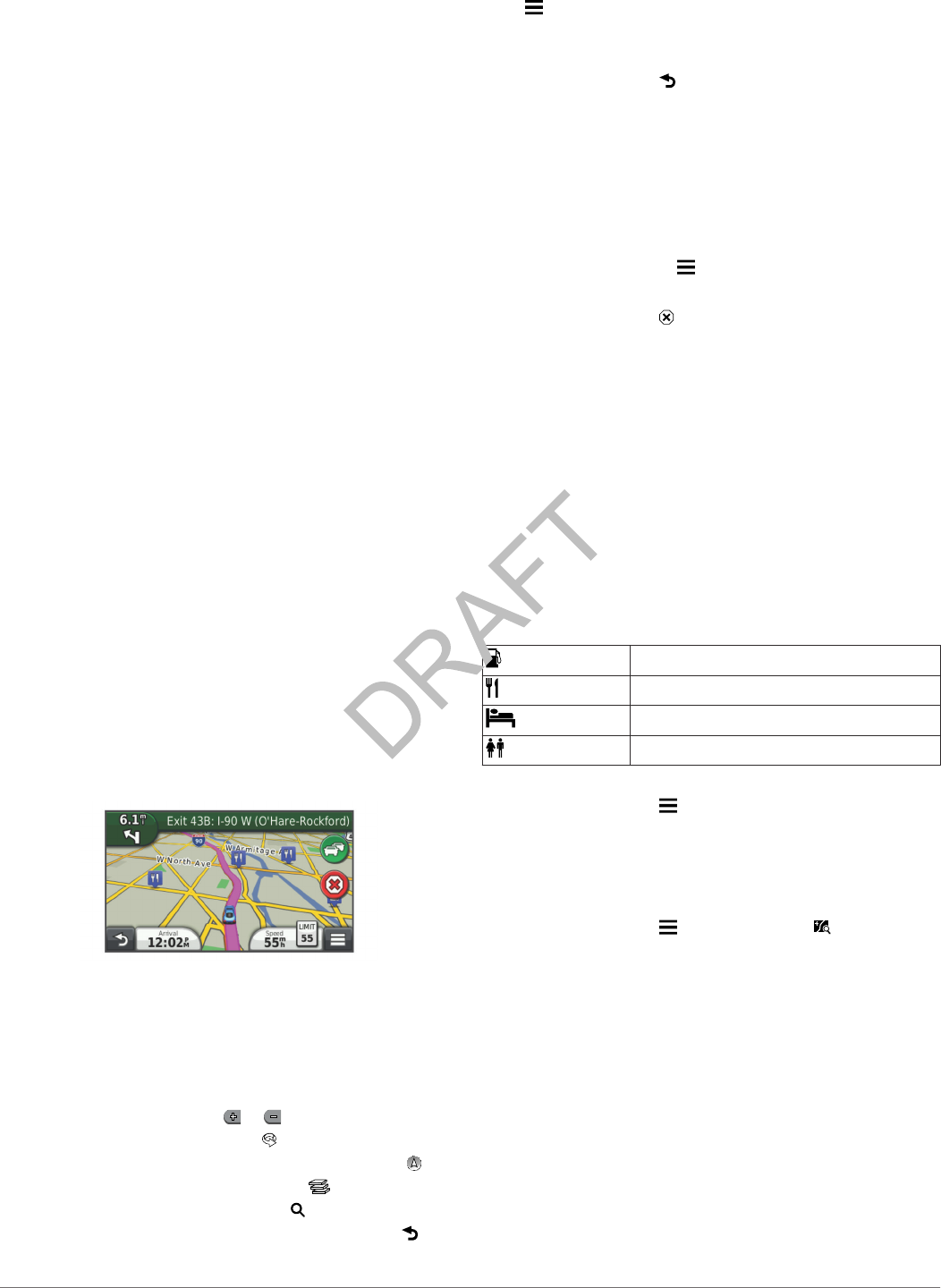
Navigation
Starting a Route
1Search for a location (page 2).
2Select a location.
3Select Go!.
4If necessary, select a route.
Changing the Route Calculation Mode
The route calculation is based on road speeds and vehicle
acceleration data for a given route. The calculation mode affects
only automobile routes.
Select Settings > Navigation > Calculation Mode.
• Select Faster Time to calculate routes that are faster to
drive but can be longer in distance.
• Select Shorter Distance to calculate routes that are
shorter in distance but can take more time to drive.
• Select Off Road to calculate point-to-point routes (without
roads).
Previewing Multiple Routes
1Search for a location (page 2).
2From the search results, select a location.
3Select Routes.
4Select a route.
5Select Go!.
Starting a Route to a Saved Location
1Select Where To? > Saved.
2If necessary, select a category, or select All Saved Places.
3Select a location.
4Select Go!.
Your Route on the Map
The route is marked with a magenta line. A checkered flag
marks your destination.
As you travel, the device guides you to the destination with
voice prompts, arrows on the map, and directions at the top of
the map. If you depart from the original route, the device
recalculates the route and provides new directions.
Using the Navigation Map
1From the main menu, select View Map.
2If the zoom controls are hidden, select the map to display the
zoom controls.
3Select the map.
4Select an option:
• To zoom in or out, select or .
• To rotate the map view, select .
• To switch between North Up and 3-D views, select .
• To add or remove map layers, select .
• To view specific categories, select .
• To center the map on your current location, select .
• To view shortcuts for map and navigation features, select
.
Adding a Point to a Route
Before you can add a stop, you must be navigating a route.
1From the map, select > Where To?.
2Search for the extra stop.
3Select the stop from the search results.
4Select Go!.
5Select Add to Active Route.
Taking a Detour
While navigating a route, you can use detours to avoid
obstacles ahead of you, such as construction zones.
While navigating, select > Detour.
Stopping the Route
From the map, select .
Using Suggested Routes
Before you can use this feature, you must save at least one
location and enable the travel history feature (page 13).
Using the feature, your device predicts your destination based
on your travel history, the day of the week, and the time of day.
After you have driven to a saved location several times, the
location may appear in the navigation bar on the map, along
with the estimated time of travel, and traffic information.
Select the navigation bar to view a suggested route to the
location.
About Exit Services
While you navigate a route, you can find gas, food, lodging, and
restrooms near upcoming exits.
Services are listed under tabs by category.
Gas
Food
Lodging
Restrooms
Finding Exit Services
1From the map, select > Exit Services.
2Use the arrows to select an upcoming exit.
3Select an exit service tab.
4Select a point of interest.
Navigating to an Exit
1From the map, select > Exit Services > .
2Select Go!.
Avoiding Road Features
1Select Settings > Navigation > Avoidances.
2Select the road features to avoid on your routes, and select
Save.
About Custom Avoidances
Custom avoidances allow you to avoid specific areas and
sections of road. You can enable and disable custom
avoidances as needed.
Avoiding an Area
1Select Settings > Navigation > Custom Avoidances.
2If necessary, select Add Avoidances.
3Select Add Avoid Area.
Navigation 5
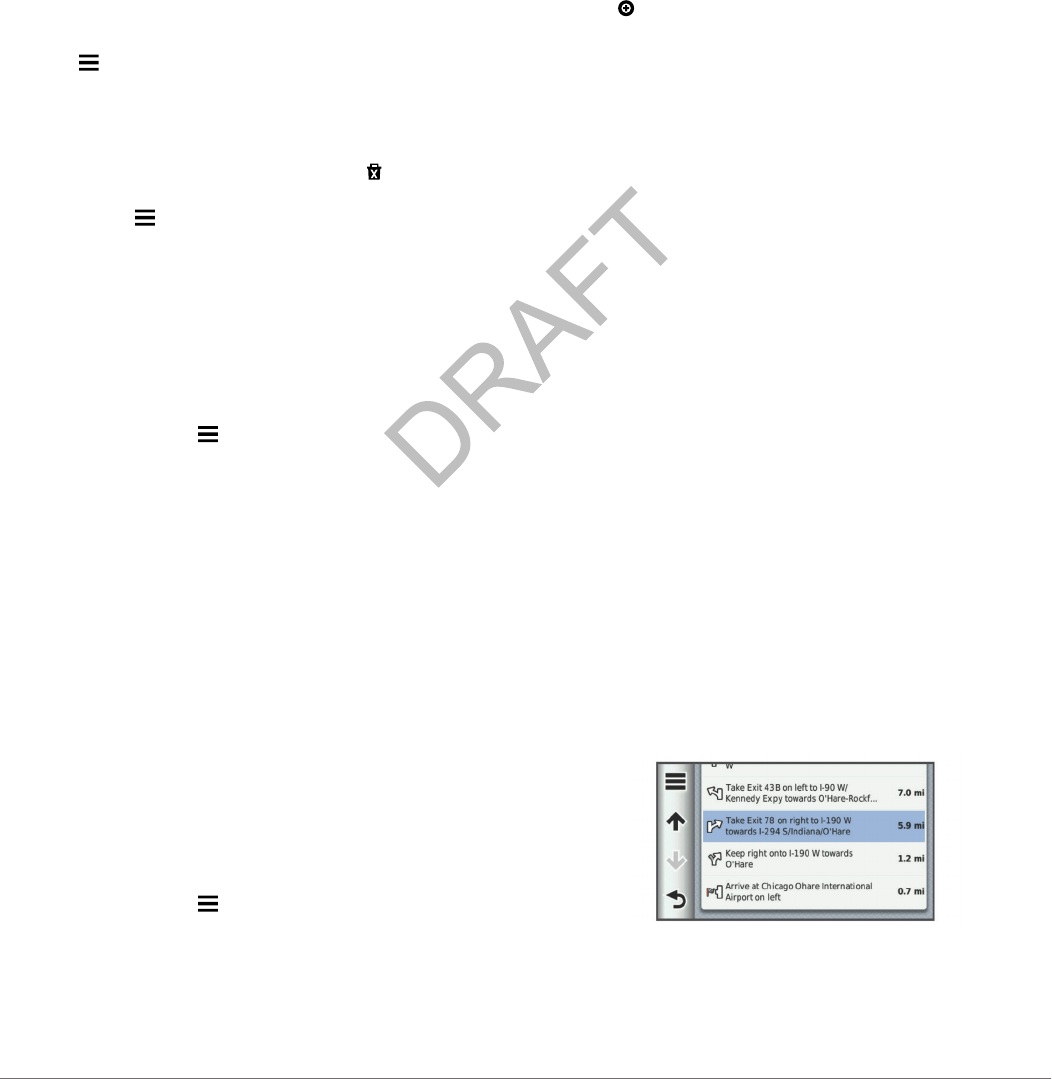
4Select the upper-left corner of the area to avoid, and select
Next.
5Select the lower-right corner of the area to avoid, and select
Next.
The selected area is shaded on the map.
6Select Done.
Avoiding a Road
1Select Settings > Navigation > Custom Avoidances.
2Select Add Avoid Road.
3Select the starting point of the section of road to avoid, and
select Next.
4Select the ending point of the road section, and select Next.
5Select Done.
Disabling a Custom Avoidance
You can disable a custom avoidance without deleting it.
1Select Settings > Navigation > Custom Avoidances.
2Select an avoidance.
3Select > Disable.
Deleting Custom Avoidances
1Select Settings > Navigation > Custom Avoidances.
2Select an option:
• To delete all custom avoidances, select .
• To delete one custom avoidance, select the avoidance,
and select > Delete.
Enabling Advanced Detours
Select Settings > Navigation > Advanced Detours.
Taking a Detour Around Specified Areas
You can take a detour for a specified distance along your route
or detour around specific roads. This is useful if you encounter
construction zones, closed roads, or poor road conditions.
1Select a destination, and select Go! (page 3).
2From the map, select > Detour.
3Select Next 0.5mi on Route, Next 2mi on Route, Next 5mi
on Route, or Detour by Road(s) on Route.
4If necessary, select a road to detour around.
Navigating Off Road
If you are not following roadways as you navigate, you can use
Off Road mode.
1Select Settings > Navigation.
2Select Calculation Mode > Off Road > Save.
The next route will be calculated as a straight line to the
location.
Map Pages
Customizing the Map
Customizing the Map Layers
You can customize which data appear on the map, such as
icons for points of interest and road conditions.
1From the map, select .
2Select Map Layers.
3Select which layers you want to include on the map, and
select Save.
Viewing the Trip Log
Your device keeps a trip log, which is a record of the path you
have traveled.
1Select Settings > Map & Vehicle > Map Layers.
2Select the Trip Log check box.
Changing the Map Data Field
1From the map, select the data field in the lower left-hand
corner.
2Select a type of data to display.
3Select Save.
Customizing Map Buttons
You can include up to two icons on the right side of the main
map.
1Select Settings > Map & Vehicle > Map Buttons.
2Select an icon, and select OK.
3Select .
4Select a different icon.
Removing Buttons from the Map
You can remove all buttons from the right side of the map.
1Select Settings > Map & Vehicle > Map Buttons.
2Select an icon, and select OK.
3Select Save.
Changing the Map Dashboard
The dashboard displays trip information at the bottom of the
map. You can select different dashboards to change the style
and the layout of the information.
1Select Settings > Map & Vehicle > Dashboards.
2Use the arrows to select a dashboard.
3Select Save.
Changing the Map Perspective
1Select Settings > Map & Vehicle > Driving Map View.
2Select an option:
• Select Track Up to display the map in two dimensions (2-
D), with your direction of travel at the top.
• Select North Up to display the map in 2-D with North at
the top.
• Select 3-D to display the map in three dimensions.
Viewing Turns
Viewing a List of Turns
While navigating a route, you can view all of the turns and
maneuvers for your entire route and the distance between turns.
1While navigating a route, select the text bar on the top of the
map.
2Select a turn.
The details for the turn appear. If available, an image of the
junction appears for junctions on major roadways.
Viewing the Entire Route on the Map
1While navigating a route, select the navigation bar at the top
of the map.
6 Map Pages
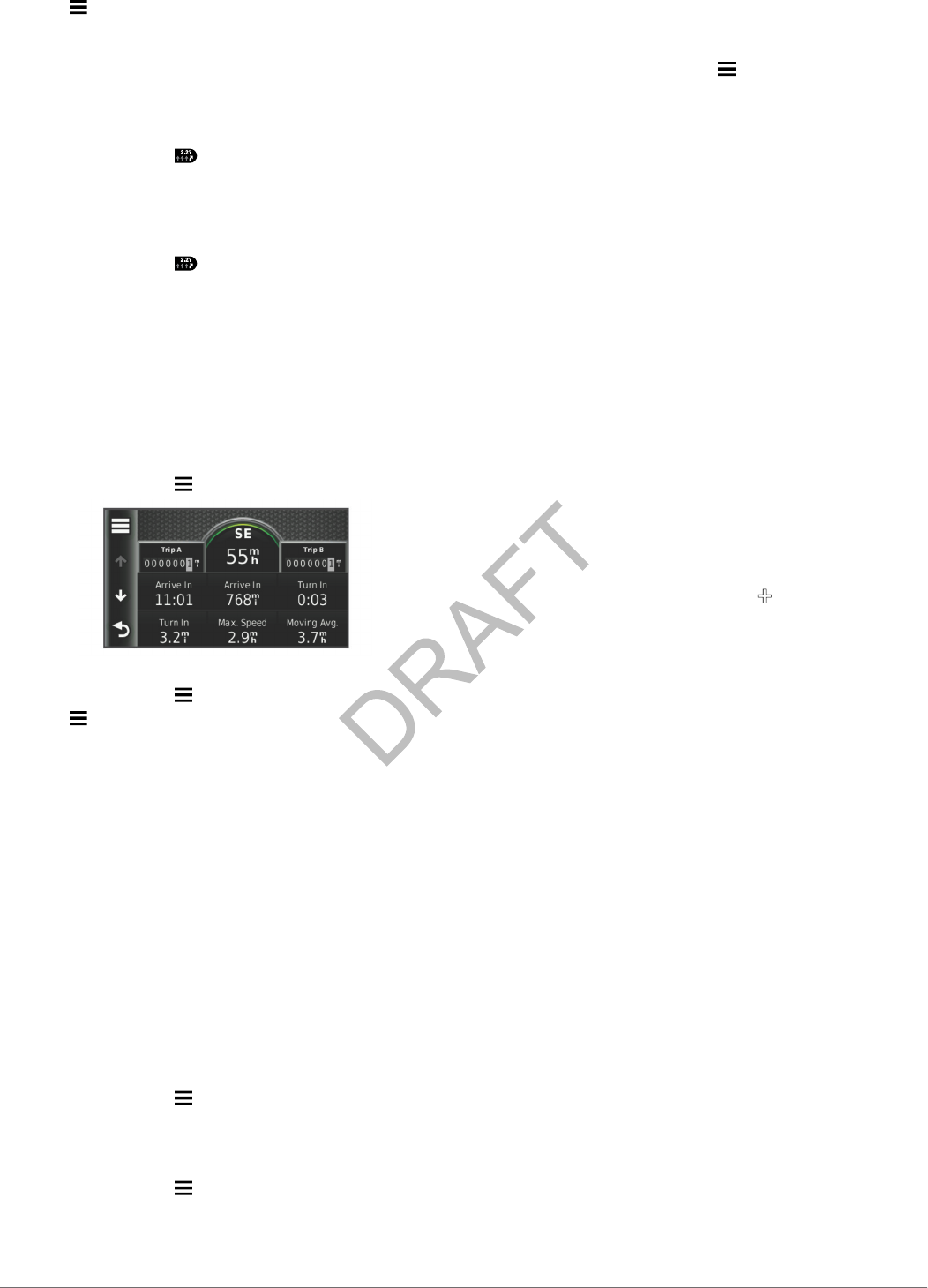
2Select > Map.
Viewing the Next Turn
While navigating an automobile route, a preview of the next
turn, lane change, or other maneuver appears in the upper-left
corner of the map.
The preview includes the distance to the turn or maneuver and
the lane in which you should be traveling, if available.
From the map, select to view the next turn on the map.
Viewing Junctions
While navigating a route, you can view the junctions on major
roadways. When you approach a junction in a route, the image
of that junction appears briefly, if available.
From the map, select to view the junction, if available.
Viewing Traffic Alerts
While navigating an automobile route, a traffic alert may appear
in the navigation bar.
Select the alert to view more information.
Viewing Trip Information
The trip information page displays your present speed and
provides statistics about your trip.
NOTE: If you make frequent stops, leave the device turned on,
so it can accurately measure elapsed time during the trip.
From the map, select > Trip Computer.
Resetting Trip Information
1From the map, select > Trip Computer.
2Select > Reset Field(s).
3Select an option:
• When not navigating a route, select Select All to reset
every data field except the speedometer, on the first
page.
• Select Reset Trip Data to reset the information on the trip
computer.
• Select Reset Max. Speed to reset the maximum speed.
• Select Reset Trip B to reset the odometer.
About Active Lane Guidance
DELETE THIS TEXT. Delete conbody tags for a title-only topic.
Using Active Lane Guidance
DELETE THIS TEXT. Delete taskbody tags for a title-only topic.
Viewing Current Location Information
You can use the Where Am I? page to view information about
your current location. This feature is helpful if you need to tell
emergency personnel your location.
From the map, select > Where Am I?.
Finding Nearby Services
You can use the Where Am I? page to find nearby services,
such as hospitals or police stations.
1From the map, select > Where Am I?.
2Select a category.
Getting Directions to Your Current Location
If you need to tell another person how to get to your current
location, your device can give you a list of directions.
Select Apps > Where Am I? > > Directions to Me.
Hands-Free Phone Calls
About Hands-Free Calling
Using Bluetooth® wireless technology, your device can connect
to your mobile phone to become a hands-free device. To
determine whether your mobile phone with Bluetooth
technology is compatible with your device, go to
www.garmin.com/bluetooth.
Your phone may not support all of the hands-free phone
features your device provides.
Enabling Bluetooth Wireless Technology
1Select Settings > Bluetooth.
2Select Bluetooth.
Pairing Your Phone
Before you can use hands-free calling, you must pair your
device with a compatible mobile phone.
1Place your phone and your Bluetooth device within 33 ft. (10
m) of each other.
2On your device, enable wireless technology.
3Select an option:
• Select Add Phone.
• If you have already paired a different phone, select
Settings > Bluetooth > Phone > .
4On your phone, enable Bluetooth wireless technology.
5On your device, select OK.
A list of nearby Bluetooth devices appears.
6Select your phone from the list, and select OK.
7If necessary, on your phone, confirm that the device is
allowed to connect.
8If necessary, enter the device Bluetooth PIN (1234) into your
phone.
Disconnecting Your Phone
1Select Settings > Bluetooth.
2Select Phone > None > Save.
Your phone is disconnected from your device but remains
paired with your phone.
Tips After Pairing the Devices
• After the initial pairing, the two devices can connect
automatically each time you turn them on.
• When your headset is connected to your device, you are
ready to receive voice prompts.
• When you turn on the device, it tries to connect to the last
headset to which it was connected.
• You might need to set your headset to connect to the device
automatically when the device is turned on.
Placing a Call
Dialing a Number
1Select Phone > Dial.
2Enter the number.
3Select Dial.
Hands-Free Phone Calls 7

Calling a Contact in Your Phone Book
Your phone book is loaded from your phone to the device each
time your phone and the device connect. It may take a few
minutes for the phone book to be available. Some phones do
not support this feature.
1Select Phone > Phone Book .
2Select a contact.
3Select Call.
Calling a Location
1Select Phone > Browse Categories.
2Select a point of interest page 2.
3Select Call.
Receiving a Call
When you receive a call, select Answer or Ignore.
Using the Call History
Your call history is loaded from your phone to the device each
time your phone and the device connect. It may take a few
minutes for the call history to be available. Some phones do not
support this feature.
1Select Phone > Call History.
2Select a category.
A list of calls appears, with the most recent calls at the top.
3Select a call.
Using In-Call Options
1While on a call, select .
2Select an option.
• To transfer audio to your phone, select Handset.
TIP: You can use this feature if you want to turn of your
device and remain on the call, or if you need privacy.
TIP: You can use this feature to use automated systems,
such as voice mail.
• To mute the microphone, select Mute.
• To hang up, select End Call.
Saving a Home Phone Number
TIP: After you save a home number, you can edit the home
number by editing “Home” in your list of saved locations
(page 4).
Select Phone > > Set Home Number, enter your phone
number, and select Done.
Calling Home
Before you can call home, you must enter a phone number for
your home location.
Select Saved > Home > > Call.
Using the Apps
Using Help
Select Apps > Help to view information about using the
device.
Searching Help Topics
Select Apps > Help > .
About Smartphone Link
DELETE THIS TEXT. Delete conbody tags for a title-only topic.
Downloading Smartphone Link
DELETE THIS TEXT. Delete taskbody tags for a title-only topic.
Connecting to Smartphone Link
DELETE THIS TEXT. Delete taskbody tags for a title-only topic.
Sending a Location from Your Phone to Your Device
DELETE THIS TEXT. Delete taskbody tags for a title-only topic.
Disabling Calls While Connected to Smartphone Link
DELETE THIS TEXT. Delete taskbody tags for a title-only topic.
About Garmin Live Services
DELETE THIS TEXT. Delete conbody tags for a title-only topic.
Subscribing to Garmin Live Services
DELETE THIS TEXT. Delete taskbody tags for a title-only topic.
About ecoRoute
DELETE THIS TEXT. Delete conbody tags for a title-only topic.
ecoRoute HD Accessory
DELETE THIS TEXT. Delete conbody tags for a title-only topic.
Setting Up the Vehicle
DELETE THIS TEXT. Delete taskbody tags for a title-only topic.
Changing the Fuel Price
DELETE THIS TEXT. Delete taskbody tags for a title-only topic.
About the ecoChallenge
DELETE THIS TEXT. Delete conbody tags for a title-only topic.
Viewing ecoChallenge Scores
DELETE THIS TEXT. Delete taskbody tags for a title-only topic.
Removing the ecoChallenge Score From the Map
DELETE THIS TEXT. Delete conbody tags for a title-only topic.
About the ecoChallenge Score
DELETE THIS TEXT. Delete conbody tags for a title-only topic.
Removing the ecoChallenge Score From the Map
DELETE THIS TEXT. Delete taskbody tags for a title-only topic.
Resetting the ecoChallenge Scores
DELETE THIS TEXT. Delete taskbody tags for a title-only topic.
Viewing Fuel Economy Information
DELETE THIS TEXT. Delete taskbody tags for a title-only topic.
Mileage Reports
DELETE THIS TEXT. Delete conbody tags for a title-only topic.
Viewing a Mileage Report
DELETE THIS TEXT. Delete taskbody tags for a title-only topic.
Resetting ecoRoute Information
DELETE THIS TEXT. Delete taskbody tags for a title-only topic.
Viewing myGarmin Message
DELETE THIS TEXT. Delete taskbody tags for a title-only topic.
Viewing the Weather Forecast
DELETE THIS TEXT. Delete taskbody tags for a title-only topic.
Viewing Weather Near a Different City
DELETE THIS TEXT. Delete taskbody tags for a title-only topic.
Viewing the Weather Radar
DELETE THIS TEXT. Delete taskbody tags for a title-only topic.
Viewing Weather Alerts
DELETE THIS TEXT. Delete taskbody tags for a title-only topic.
8 Using the Apps

Checking Road Conditions
DELETE THIS TEXT. Delete taskbody tags for a title-only topic.
Planning a Trip
You can use the trip planner to create and save a trip with
multiple destinations.
1Select Apps > Trip Planner.
2Select New Trip.
3Select Select Start Location.
4Search for a location (page 2).
5Select Select.
6To add additional locations, select .
7Select Next.
8Enter a name, and select Done.
Scheduling a Trip
You can use the trip planner to create and save a trip with
multiple destinations.
1Select Apps > Trip Planner.
2Select a trip.
3Select a location.
4Select Departure Time (or Arrival Time if the location is not
the first stop in the trip).
5Select a date and time, and select Save.
6Select Duration.
7Select the amount of time you will spend at the location, and
select Save.
8If necessary, repeat steps 3–7 for each location.
Changing Transportation Modes in a Trip
You can change the transportation modes used to travel in a
saved trip.
1Select Apps > Trip Planner.
2Select a trip.
3Select > Transportation Mode.
4Select a transportation mode.
5Select Save.
Navigating to a Saved Trip
1Select Apps > Trip Planner.
2Select a saved trip.
3Select Go!.
4If prompted, select a route (page 5).
Editing a Saved Trip
1Select Apps > Trip Planner.
2Select a saved trip.
3Select .
4Select an option:
• Select Rename Trip.
• Select Edit Destinations to add and delete location, or to
change the order of locations.
• Select Delete Trip.
• Select Optimize Order to arrange the stops on your trip
in the most-efficient order.
Viewing Pictures
You can view pictures that you have stored in the device or on a
memory card. See page 12 for more information about loading
pictures on the device.
1Select Apps > Picture Viewer.
2Use the arrows to scroll through the images.
3Select a picture.
Viewing a Slideshow
1Select Apps > Picture Viewer.
2Select .
3While a slideshow is playing, select the screen to stop the
slideshow.
Setting a Picture as Wallpaper
Paragraph in a context element.
1Select Apps > Picture Viewer.
2Select a picture.
3Select > Set as Wallpaper .
4Use the on-screen bullets to adjust the wallpaper.
5Select Done.
Deleting Pictures
1Select Apps > Picture Viewer.
2Select a picture.
3Select > Delete > Yes.
Viewing Previous Routes and Destinations
Before you can use this feature, you must enable the travel
history feature (page 13).
You can view your previous routes and places you have
stopped on the map.
Select Apps > Where I've Been.
Using the World Clock
1Select Apps > World Clock.
2If necessary, select a city, enter a city name, and select
Done.
Viewing the World Map
Select Apps > World Clock > .
Nighttime hours appear in the shaded area of the map.
Setting an Alarm
1Select Apps > Alarm Clock.
2Set a time.
3Select the Alarm On check box.
Using the Calculator
Select Apps > Calculator.
Converting Units
1Select Apps > Unit Converter.
2If necessary, select the button next to Convert, select a
measurement category, and select Save.
3If necessary, select a unit button, select a unit of
measurement, and select Save.
4Select the field below the unit you want to convert.
5Enter the number, and select Done.
Setting Currency Conversion Rates
This feature is not available in all areas.
You can update the currency conversion rates for the unit
converter.
1Select Apps > Unit Converter.
2Select the button next to Convert.
3Select Currency, and select Save.
Using the Apps 9
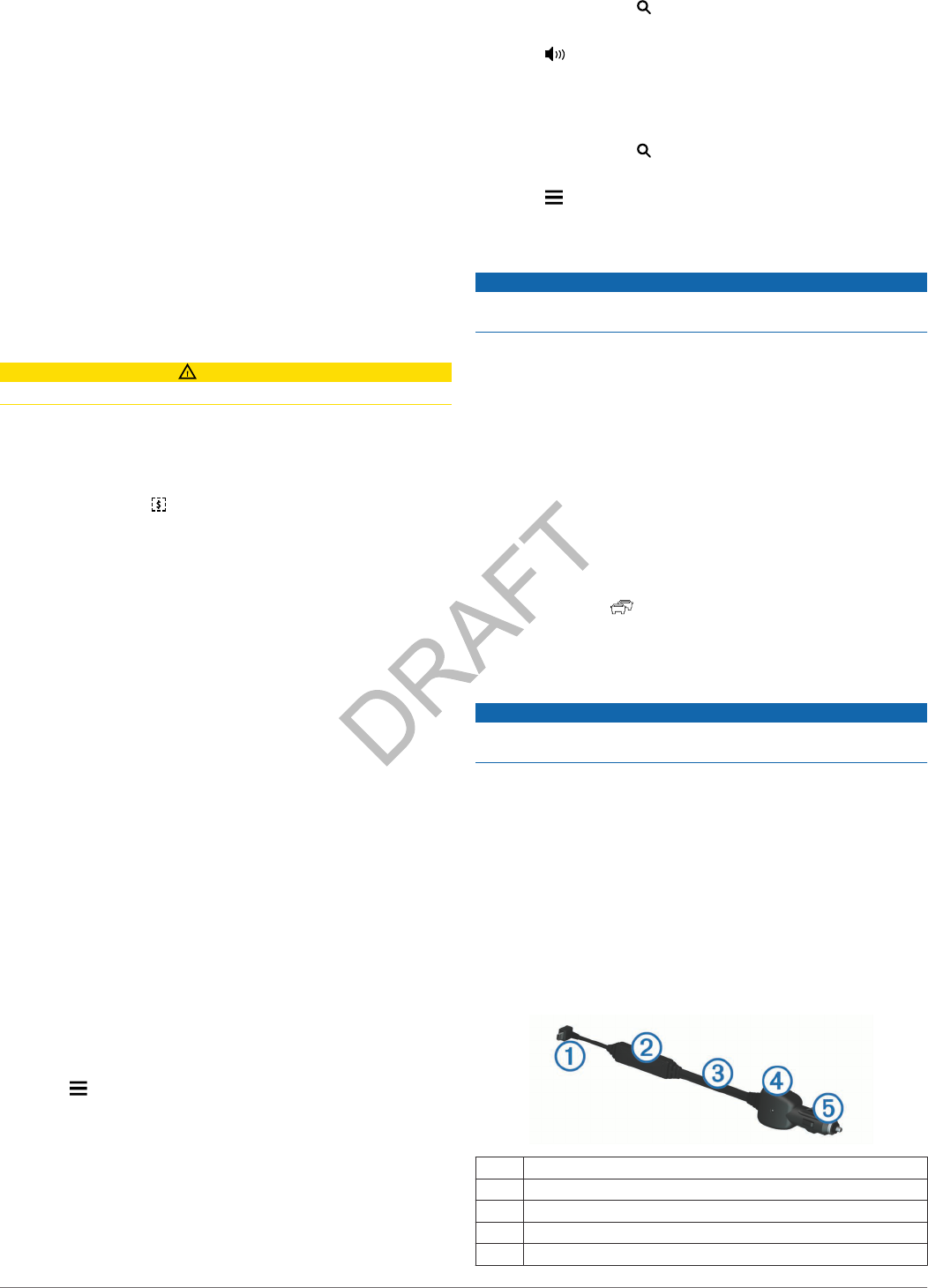
4If necessary, select a currency button, select a different
currency, and select Save.
5Select the button at the bottom of the screen that displays
the currency conversion rates.
6Select the box next to a currency.
7Enter a value, and select Done.
8Select OK.
About Offers
If your device package includes a traffic receiver, you will
receive location-relevant offers and coupons. Ad-based traffic
information is available only in North America.
NOTE: The traffic receiver must be connected to external power
and you must be in a coverage area to receive ad-based traffic
information.
See our privacy statement at www.garmin.com/privacy.
Viewing Offers
CAUTION
Do not attempt to write down the coupon codes while driving.
This feature is available only if you are using an ad-supported
lifetime traffic receiver.
1Select an offer that appears on the screen to search for the
nearest location related to that offer.
2If available, select to view coupon information.
3Write down this code and present it when you arrive at the
location.
Viewing an Offer List
This feature is available only if you are using an ad-supported
lifetime traffic receiver.
Select Apps > Offers.
Disabling Traffic and Offers
1Select Traffic > Traffic.
2Clear the Traffic check box.
The device no longer receives live traffic data, but automobile
routes still avoid potentially congested areas using
trafficTrends™, if enabled (page 13).
Using the Language Guide
Use the Language Guide to look up and translate words or
phrases.
Select Apps > Language Guide.
Purchasing the Language Guide
Your device comes with a limited demonstration version of the
language guide.
To purchase the full language guide, go to
http://www.garmin.com/languageguide.
Selecting Languages in the Language Guide
You can select the languages you want to translate when
translating words and phrases.
1Select Apps > Language Guide.
2Select > Language.
3Select From, select the language to translate from, and
select Save.
4Select To, select the language to translate to, and select
Save.
Translating Words and Phrases
1Select Apps > Language Guide.
2Select a category and subcategories.
3If necessary, select , enter a keyword, and select Done.
4Select a word or a phrase.
5Select to listen to the translation.
Using a Bilingual Dictionary
1Select Apps > Language Guide > Bilingual Dictionaries.
2Select a dictionary.
3If necessary, select , enter a word, and select Done.
4Select a word.
5Select to listen to the translation.
About Traffic
NOTICE
Garmin is not responsible for the accuracy or timeliness of the
traffic information.
Traffic information may not be available in all areas or countries.
For information about traffic receivers and coverage areas, go
to http://www.garmin.com/traffic.
A traffic receiver is included in some packages, built into either
the vehicle power cable or the device, and is an optional
accessory for all models.
• The device must be connected to vehicle power to receive
traffic information.
• The powered traffic receiver and the device must be in data
range of a station transmitting traffic data to receive traffic
information.
• You do not need to activate the subscription included with
your traffic receiver.
• The traffic icon ( ) changes color to indicate the severity of
traffic conditions on your route or on the road you are
currently traveling.
Receiving Traffic Data
NOTICE
Heated (metallized) windshields could degrade the performance
of the traffic receiver.
Before you can receive traffic data, you must purchase a
compatible traffic receiver accessory. Go to www.garmin.com
for more information.
Before you can receive traffic data, the traffic receiver and the
device must be in data range of an FM station transmitting
traffic information.
When the receiver is within a traffic coverage area, your device
will begin displaying traffic information.
1Connect the traffic receiver to an external power source.
2Connect the traffic receiver to the device.
Traffic Receiver
ÀMini-USB connector
ÁExternal antenna connector
ÂInternal antenna
ÃPower LED
ÄVehicle power adapter
10 About Traffic

About the Traffic Icon
When you are receiving traffic information, a traffic icon appears
on the map. The traffic icon changes color to indicate the
severity of traffic conditions.
Gray: Traffic information is not available.
Green: Traffic is flowing freely.
Red: Traffic is not moving or moving very slowly. There is a
severe delay.
Yellow: Traffic is moving, but there is a delay. There is
moderate traffic congestion.
Traffic on Your Route
When calculating your route, the device examines the current
traffic and automatically optimizes the route for the shortest
time. If a severe traffic delay occurs on your route while you are
navigating, your device automatically recalculates the route.
The traffic icon changes color to indicate the severity of
traffic conditions on your route or on the road you are currently
traveling.
Your device may route you through a traffic delay if a better
alternative route does not exist. The delay time is added into
your estimated time of arrival automatically.
Viewing Traffic on Your Route
1While navigating a route, select .
2Select Traffic on Route.
A list of traffic events appears, organized by their location on
the route.
3Select an event.
Manually Avoiding Traffic on Your Route
1From the map, select .
2Select Traffic on Route.
3If necessary, use the arrows to view other traffic delays on
your route.
4Select > Avoid.
Taking an Alternate Route
1While navigating an automobile route, select .
2Select Alternate Route.
3Select a route.
Viewing Traffic on the Map
The traffic map shows color-coded traffic flow and delays on
nearby roads.
1From the map, select .
2Select Traffic Conditions.
Traffic in Your Area
Searching for Traffic Delays
1From the map page, select .
2Select Traffic Conditions > .
3Select an item in the list.
4If there is more than one delay, use the arrows to view
additional delays.
Viewing a Traffic Incident on the Map
1From the map, select .
2Select Traffic Conditions.
3Select a traffic icon.
Understanding Traffic Data
The traffic legend explains the icons and colors used on the
traffic map.
1From the map, select > Traffic.
2Select Traffic Legend.
Traffic Subscriptions
Subscription Activation
You do not need to activate the subscription included with your
FM traffic receiver. The subscription activates automatically
after your device acquires satellite signals while receiving traffic
signals from the pay service provider.
Adding a Subscription
You can purchase traffic subscriptions for other regions or
countries.
1From the main menu, select Traffic.
2Select Subscriptions > .
3Write down the FM traffic receiver unit ID.
4Go to www.garmin.com/fmtraffic to purchase a subscription
and get a 25-character code.
The traffic subscription code cannot be reused. You must
obtain a new code each time you renew your service. If you
own multiple FM traffic receivers, you must obtain a new
code for each receiver.
5Select Next on the device.
6Enter the code.
7Select Done.
Disabling Traffic
1Select Settings > Traffic.
2Clear the Traffic check box.
The device no longer receives live traffic data, but will still avoid
potentially congested areas using trafficTrends, if enabled
(page 13).
Using Trucking Features
DELETE THIS TEXT. Delete taskbody tags for a title-only topic.
About IFTA Logging
DELETE THIS TEXT. Delete conbody tags for a title-only topic.
Entering Fuel Data
DELETE THIS TEXT. Delete taskbody tags for a title-only topic.
Using Fuel Logs
DELETE THIS TEXT. Delete taskbody tags for a title-only topic.
Viewing and Exporting a Jurisdiction Summary
DELETE THIS TEXT. Delete taskbody tags for a title-only topic.
Using Trip Reports
DELETE THIS TEXT. Delete taskbody tags for a title-only topic.
Viewing Exported Jurisdiction Summaries and Trip
Reports
DELETE THIS TEXT. Delete taskbody tags for a title-only topic.
About Hours of Service
DELETE THIS TEXT. Delete conbody tags for a title-only topic.
Recording Your Duty Status
DELETE THIS TEXT. Delete taskbody tags for a title-only topic.
Using Driving Logs
DELETE THIS TEXT. Delete taskbody tags for a title-only topic.
About Drivers
DELETE THIS TEXT. Delete conbody tags for a title-only topic.
Using Trucking Features 11

Adding Drivers
DELETE THIS TEXT. Delete taskbody tags for a title-only topic.
Managing Driver Information
DELETE THIS TEXT. Delete taskbody tags for a title-only topic.
Adding Shipments
DELETE THIS TEXT. Delete taskbody tags for a title-only topic.
Managing Shipments
DELETE THIS TEXT. Delete taskbody tags for a title-only topic.
Exporting Driving Logs
DELETE THIS TEXT. Delete taskbody tags for a title-only topic.
Viewing Exported Driving Logs
DELETE THIS TEXT. Delete taskbody tags for a title-only topic.
Data Management
About Data Management
You can store files, such as JPEG image files, on your device.
The device has a memory card slot for additional data storage.
NOTE: The device is not compatible with 95, 98, Me, , and OS
10.3 and earlier.
File Types
The device supports these file types.
• Maps and GPX waypoint files from mapping software,
includingMapSource®, , and HomePort™ (page 15).
• GPI custom POI files from Garmin POI Loader (page 15).
About Memory Cards
You can purchase memory cards from an electronics supplier,
or purchase pre-loaded Garmin mapping software
(http://www.garmin.com/trip_planning). In addition to map and
data storage, the memory card can be used to store files such
as maps, images, geocaches, routes, waypoints, and custom
POIs.
Installing a Memory Card
The device supports and microSDHC memory cards.
1Insert a memory card into the slot on the device.
2Press it in until it clicks.
Connecting the Device to Your Computer
You can connect the device to your computer using the USB
cable included with your device.
NOTE: The first time you connect your device to your computer,
you will be prompted to install the Agent software. Go to
http://www.garmin.com/agent for more information.
1Plug the small end of the USB cable into the port on the
device.
2Plug the larger end of the USB cable into an available USB
port on your computer.
A picture of your device connected to a computer appears on
the device screen.
On a Windows computer, your device appears in My
Computer as either a portable device or as two removable
drives representing the device and the memory card.
Transferring Data From Your Computer
1Connect the device to your computer (page 12).
Your device and memory card appear as removable drives in
My Computer in Windows and as mounted volumes on Mac
computers.
NOTE: Some computers with multiple network drives cannot
display device drives. See your operating system Help file to
learn how to map the drive.
2On your computer, open the file browser.
3Select the file.
4Select Edit > Copy.
5Open the Garmin or memory card drive or volume.
6Select Edit > Paste.
The file appears in the list of files in the device memory or on
the memory card.
Disconnecting the USB Cable
If your device is connected to your computer as a removable
drive or volume, you must safely disconnect your device from
your computer to avoid data loss. If your device is connected to
your computer as a portable device, it is not necessary to safely
disconnect.
1Complete an action:
• For computers, select the Safely Remove Hardware icon
in the system tray, and select your device.
• For computers, drag the volume icon to the Trash.
2Disconnect the cable from your computer.
Deleting Files
NOTICE
If you do not know the purpose of a file, do not delete it. Your
device memory contains important system files that should not
be deleted.
1Open the Garmin drive or volume.
2If necessary, open a folder or volume.
3Select a file.
4Press the Delete key on your keyboard.
Customizing the Device
Adding Truck or RV Profiles
DELETE THIS TEXT. Delete taskbody tags for a title-only topic.
Adding Truck or RV Profiles
DELETE THIS TEXT. Delete taskbody tags for a title-only topic.
Editing Truck or RV Profiles
DELETE THIS TEXT. Delete taskbody tags for a title-only topic.
Map and Vehicle Settings
Select Settings > Map & Vehicle.
Vehicle: Changes the icon to represent your position on the
map. Go to http://www.garmingarage.com for more icons.
Driving Map View: Sets the perspective on the map.
Map Detail: Sets the level of detail on the map. More detail may
cause the map to draw slower.
Map Theme: Changes the color of the map data.
Map Buttons: Sets which icons are included on the map. Up to
two icons can be included on the map.
Map Layers: Sets the data that appears on the map page
(page 6).
Dashboards: Sets the map dashboard layout.
myMaps: Sets which installed maps the device uses.
Enabling Maps
You can enable map products that are installed on your device.
12 Data Management

TIP: To purchase additional map products, go to
http://www.garmin.com/us/maps.
1Select Settings > Map & Vehicle > myMaps.
2Select a map.
Navigation Settings
Select Settings > Navigation.
Calculation Mode: Sets route preference.
Off-Route Recalculation: Sets how your device recalculates a
route if you deviate from the route.
Avoidances: Sets road features to avoid on a route.
Custom Avoidances: Allows you to avoid specific roads or
areas.
Advanced Detours: Sets the length of the detour.
Safe Mode: Disables all functions that require significant
operator attention and could become a distraction while
driving.
GPS Simulator: Stops the device from receiving a GPS signal,
and saves battery power.
Route Preferences
Select Settings > Navigation > Calculation Mode.
The route calculation is based on road speeds and vehicle
acceleration data for a given route.
Faster Time: Calculates routes that are faster to drive but can
be longer in distance.
Shorter Distance: Calculates routes that are shorter in distance
but can take more time to drive.
Less Fuel: Calculates routes that could use less fuel than other
routes.
Off Road: Calculates a direct line from your location to your
destination.
Display Settings
Select Settings > Display.
Color Mode: Changes the brightness of the screen. Decreasing
the brightness can save battery power.
Display Timeout: Sets the amount of idle time before your
device enters sleep mode.
Screenshot: Allows you to take a picture of the device screen.
Screenshots are saved in the Screenshot folder of the
device storage.
Settings
Select Settings > Bluetooth.
Bluetooth: Enables wireless technology.
Add Headset: Manages connection between your device and
wireless headsets with wireless technology.
Friendly Name: Allows you to enter a friendly name that
identifies your devices with wireless technology.
Disabling Bluetooth
1Select Settings > Bluetooth.
2Select Bluetooth.
Traffic Settings
Select Settings > Traffic.
Traffic: Enables traffic.
Subscriptions: Lists current traffic subscriptions.
trafficTrends: See page 13.
About Traffic Subscriptions
You can purchase additional subscriptions or a renewal if your
subscription expires. Go to http://www.garmin.com/traffic.
Viewing Traffic Subscriptions
Select Settings > Traffic > Subscriptions.
trafficTrends
When the trafficTrends feature is enabled, your device records
historic traffic data and uses that data to calculate more-efficient
routes.
When you drive with the trafficTrends feature enabled, your
device records traffic data that is used to improve the
trafficTrends historical traffic information. This information is
sent to Garmin when you connect your device to myGarmin
using your computer.
NOTE: Different routes may be calculated based on traffic
trends for the day of the week or the time of day.
Disabling trafficTrends
To prevent your device from recording or sharing traffic data,
you must disable trafficTrends.
Select Settings > Traffic > trafficTrends.
Units and Time Settings
Select Settings > Units & Time.
Current Time: Sets the device time.
Time Format: Allows you to select a 12-hour, 24-hour, or UTC
display time.
Units: Sets the unit of measure used for distances.
Language and Keyboard Settings
Select Settings > Language & Keyboard.
Voice Language: Sets the language for voice prompts.
Text Language: Sets all on-screen text to the selected
language.
NOTE: Changing the text language does not change the
language of user-entered data or map data, such as street
names.
Keyboard Language: Sets the language for your keyboard.
Keyboard Layout: Sets the keyboard layout.
Mode-Adaptive Keyboard: Changes keyboard layout when
you change transportation modes.
Device and Privacy Settings
Select Settings > Device.
About: Displays the software version number, the unit ID
number, and information on several other software features.
EULAs: Displays the end-user license agreements that apply to
your choice.
NOTE: You need this information when you update the
system software or purchase additional map data
(page 15).
Travel History: Allows the device to record information for the
myTrends (page 5), Where I’ve Been (page 9) and Trip Log
(page 6) features.
Clear Travel History
Proximity Alerts Settings
Select Settings > Proximity Alerts.
Audio: Sets the style of alert that plays when you approach
proximity points.
Alerts: Sets the type of proximity points for which alerts are
played.
Customizing the Device 13
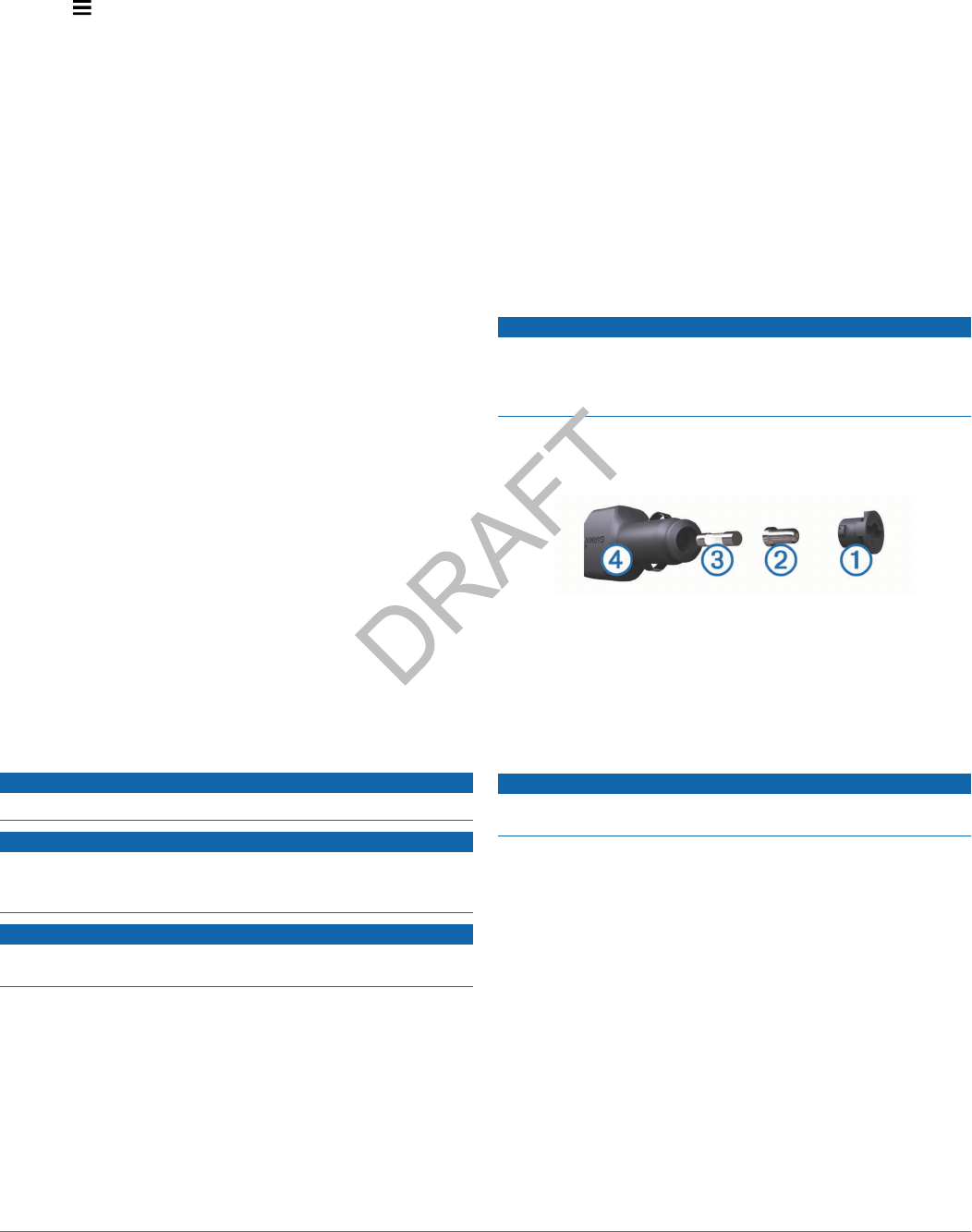
Restoring Settings
You can restore a category of settings or all settings to the
factory default values.
1Select Settings.
2If necessary, select a settings category.
3Select > Restore.
Appendix
Warning Icons
DELETE THIS TEXT. Delete conbody tags for a title-only topic.
Restriction Warnings
DELETE THIS TEXT. Delete conbody tags for a title-only topic.
Road Condition Warnings
DELETE THIS TEXT. Delete conbody tags for a title-only topic.
Other Warnings
DELETE THIS TEXT. Delete conbody tags for a title-only topic.
Using a Backup Camera
DELETE THIS TEXT. Delete taskbody tags for a title-only topic.
Power Cables
Your device can be powered various ways.
• Motorcycle power cable
• Vehicle power cable
• USB cable
• AC adapter (optional accessory)
Charging the Device
You can charge the battery in the device using any of these
methods:
• Connect the device to the vehicle power cable.
• Connect the device to the motorcycle power cable.
• Connect the device to a computer using the included USB
cable.
• Connect the device to an optional power adapter accessory,
such as a wall power adapter.
About Device Care
NOTICE
Avoid dropping your device.
NOTICE
Do not store the device where prolonged exposure to extreme
temperatures can occur, because it can cause permanent
damage.
NOTICE
Never use a hard or sharp object to operate the touchscreen, or
damage may result.
Cleaning the Outer Casing
1Clean the outer casing of the device (not the touchscreen)
using a cloth dampened with a mild detergent solution.
2Wipe the device dry.
Cleaning the Touchscreen
1Use a soft, clean, lint-free cloth.
2If necessary, use water, isopropyl alcohol, or eyeglass lens
cleaner.
3Apply the liquid to the cloth.
4Gently wipe the screen with the cloth.
Avoiding Theft
• Remove the device and mount from sight when not in use.
• Remove the residue left on the windshield by the suction
cup.
• Do not keep your unit in the glove compartment.
• Register your device at http://my.garmin.com.
Extending the Battery Life
• Keep your device away from extreme temperatures.
• Put the device in sleep mode (page 1).
• Decrease the screen brightness (page 13).
• Do not leave your device in direct sunlight.
• Decrease the volume (page 1).
• Disable Bluetooth (page 13).
• Shorten the display timeout time (page 13).
Changing the Fuse in the Vehicle Power
Cable
NOTICE
When replacing the fuse, do not lose any of the small pieces
and make sure they are put back in the proper position. The
vehicle power cable does not work unless it is assembled
correctly.
If your device does not charge in your vehicle, you may need to
replace the fuse located at the tip of the vehicle adapter.
1Unscrew the end piece À.
TIP: You may need to use a coin to remove the end piece.
2Remove the end piece, the silver tip Á, and the fuse Â.
3Install a 2 A fast-blow fuse.
4Place the silver tip in the end piece.
5Screw the end piece back into the vehicle power cable Ã.
Mounting on Your Dashboard
NOTICE
The permanent mounting adhesive is extremely difficult to
remove after it is installed.
Use the mounting disk to mount your device to the dashboard
and comply with certain state regulations. See www.garmin.com
for more information.
1Clean and dry the dashboard where you are placing the disk.
2Remove the backing from the adhesive on the bottom of the
disk.
3Place the disk on the dashboard.
4Remove the clear plastic cover from the top of the disk.
5Place the suction cup mount on top of the disk.
6Flip the lever down (toward the disk).
Removing the Device, Cradle, and Mount
Removing the Device from the Cradle
1Press the tab on the top of the cradle.
2Tilt the device forward.
14 Appendix

Removing the Cradle from the Mount
1Turn the cradle to the right or left.
2Apply pressure until the socket on the cradle releases the
ball on the mount.
Removing the Suction Cup Mount from the
Windshield
1Flip the lever on the suction cup mount toward you.
2Pull the tab on the suction cup toward you.
Purchasing Additional Maps
1Go to your device product page on the Garmin web site
(http://www.garmin.com).
2Click the Maps tab.
3Follow the on-screen instructions.
Safety Cameras
NOTICE
Garmin is not responsible for the accuracy of or the
consequences of using a custom point of interest or a safety
camera database.
Safety camera information is available in some locations. Check
http://my.garmin.com for availability. For these locations, you
can purchase a subscription for safety camera information. The
subscription includes the locations of hundreds of safety
cameras. Your device alerts you when you are approaching a
safety camera and can warn you if you are driving too fast. The
data is updated at least weekly, so you can update your device
regularly to receive the most up-to-date information.
You can purchase a new region or extend an existing
subscription at any time. Each region that you purchase has an
expiration date.
Custom Points of Interest
Custom POIs are customized points on the map. They can
contain alerts that let you know if you are near a designated
point or if you are traveling faster than a specified speed.
Installing POI Loader Software
You can create or download custom POI lists on your computer
and install them on your device using POI Loader software.
1Go to http://www.garmin.com/extras.
2Click Services > POI Loader.
3Install the POI Loader onto your computer.
Using the POI Loader Help Files
For more information on the POI loader, refer to the Help file.
With the POI loader open, click Help.
Finding Extras
1Select Where To? > Categories > Custom POIs.
2Select a category.
Purchasing Accessories
Go to http://buy.garmin.com.
Troubleshooting
Problem Solution
My device is not
acquiring satellite
signals.
• Verify the GPS simulator is turned off
(page 13).
• Take your device out of parking garages and
away from tall buildings and trees.
• Remain stationary for several minutes.
Problem Solution
The suction cup will
not stay on my
windshield.
1Clean the suction cup and windshield with
rubbing alcohol.
2Dry with a clean, dry cloth.
3Mount the suction cup ().
The device does not
charge in my
vehicle.
• Check the fuse in the vehicle power cable
(page 14).
• Verify the vehicle is turned on and is supplying
power to the power outlet.
• Your device can only charge between 32°F
and 113°F (between 0°C and 45°C).
My battery does not
stay charged for
very long.
• Decrease the screen brightness (page 13).
• Shorten the display timeout (page 13).
• Decrease the volume (page 1).
• Disable Bluetooth wireless technology
(page 13).
• Put the device in sleep mode when not in use
(page 1).
• Keep your device away from extreme
temperatures.
• Do not leave your device in direct sunlight.
My battery gauge
does not seem
accurate.
Allow the unit to fully discharge, and fully charge
it (without interrupting the charge cycle).
How do I know my
device is connected
to my computer?
When your device is connected using Media
Transfer Protocol (MTP) or USB mass storage
mode, a picture of a device connected to a
computer is shown on the device screen.
The device is
connected to the
computer, but it will
not go into MTP
mode or mass
storage mode.
1Disconnect the USB cable from your
computer.
2Turn off the device.
3Plug the USB cable into a USB port on your
computer and into your device.
The device automatically turns on and goes
into MTP mode or USB mass storage mode.
4Verify your device is connected to a USB port
and not a USB hub.
My phone will not
connect to the
device.
• From the main menu, select Settings >
Bluetooth. The Bluetooth field must be set to
Enabled.
• Turn on your phone and bring it within 33 feet
(10 m) of the device.
• Go to http://www.garmin.com/bluetooth for
more help.
Appendix 15

Index
Symbols
3-D map view 6
A
accessories 15
adding stops 5
advanced detours 6
alarm 9
alerts
audio 13
proximity points 13
safety cameras 13
traffic 7
answering calls 8
audio, proximity points 13
avoidances
area 5
customizing 5
deleting 6
disabling 6
road 6
road features 5
B
battery
charging 2, 14
maximizing 14
Bluetooth technology
disabling 13
enabling 7
settings 13
brightness 1, 13
C
cables, power 14
calculator 9
calls
answering 8
call waiting 8
contacts 8
dialing 7
history 8
home 8
placing 7
cameras, safety 15
changing search area 3
charging the device 2, 14
cleaning the device 14
clock 9
computer, connecting 12
converting
currency, converting 9
units 9
coordinates 3
coupon code 10
cradle, removing 15
current location 7
custom POIs 15
customizing, avoidances 5
customizing the device 12
D
dashboard mount 14
deleting
all user data 12
trips 9
deleting pictures 9
destinations. 9 See also locations
detours, advanced 6
device, registering 1
device care 14
dialing 7
directions 6
disconnecting phone 7
display settings 13
driving directions 6
E
EULAs 13
exit services, finding 5
extras
custom points of interest 15
safety cameras 15
F
files
supported types 12
transferring 12
finding locations. See also locations
addresses 3
browsing the map 3
categories 2
cities 3
coordinates 3
intersections 3
using the map 3
fuse, changing 14
G
geocaching 3
going home 4
GPS 2
H
hands-free phone calls 7
help. 8 See also product support
home
calling 8
editing location 4
going 4
phone number 8
setting locations 3
I
icons, traffic 11
ID number 13
J
junction view 7
K
keyboard
language 13
layout 13
L
language
keyboard 13
voice language 13
latitude and longitude, coordinates 3
locations
calling 8
current 4, 7
recently found 4
saving 4
searching for 3
setting home 3
simulated 4
M
map
data field 6
reporting errors 3
map perspective 6
map view
2-D 6
3-D 6
maps
browsing 3
detail level 12
nüMaps Guarantee 1
nüMaps Lifetime 1
purchasing 15
theme 12
traffic conditions 11
updating 1
viewing routes 6
memory card 12
microSD card, installing 12
mounting the device
dashboard 14
removing from mount 14
suction cup 15
myDashboard, updating software 1
myTrends, routes 5
N
navigation
off-road 6
previewing routes 5
settings 13
next turn 7
nüMaps Guarantee 1
nüMaps Lifetime 1
O
off-road navigation 6
offers
coupon code 10
viewing 10
on-screen buttons 2
P
pairing
disconnecting 7
phone 7
parking, last spot 4
phone
disconnecting 7
pairing 7
phone calls
answering 8
call waiting 8
dialing 8
muting 8
voice dial 8
picture viewer, deleting pictures 9
POI. 15 See also point of interest (POI)
POI Loader 15
points of interest (POI Loader) 15
points of interest (POI)
custom 15
extras 15
POI Loader 15
rating 3
power cables, changing the fuse 14
power key, turn off device 1
product support 8
proximity points alerts, settings 13
Q
Quick Search 2
R
rating, points of interest 3
recently found locations 4
registering the device 1
removing cradle 15
renaming trips 9
reporting POI errors 3
resetting
device 1
trip data 7
restoring settings 14
routes
calculating 5
myTrends 5
preferences 13
previewing 5
recalculating 11
starting 4, 5
stopping 5
suggested 5
viewing on the map 6
S
safety cameras, database 15
satellite signals
acquiring 2
16 Index

viewing 2
saved locations
categories 4
deleting 4
editing 4
favorites 4, 5
saving, current location 4
screen, brightness 1
screenshot 13
search bar 3
setting wallpaper 9
settings 13
shortcuts
adding 2
removing 2
simulated locations 4
sleep mode
entering 1
exiting 1
software, version 13
stops, adding 5
subscriptions
nüMaps Lifetime 1
traffic 1
suction cup 15
T
theft, avoiding 14
time settings 2, 13
traffic
activating a subscription 11
adding subscriptions 11
alerts 7
alternate route 11
avoiding 11
data 11
disabling 10, 11
icons 11
incidents 11
lifetime subscriptions 1
recalculating routes 11
receiver 10
route recalculations 11
searching for delays 11
trafficTrends 13
trafficTrends, disabling 13
transportation modes
automotive 2
changing 9
motorcycle 2
travel history 13
trip computer, resetting information 7
trip data, resetting 7
trip information, viewing 7
trip log, viewing 6
trip planner, editing a trip 9
turn list 6
U
unit converter 9
unit ID 13
updates, software 1, updating 1
USB, disconnecting 12
user data, deleting 12
V
volume, adjusting 1
W
wallpaper 9
Where Am I? 4, 7
Index 17

www.garmin.com/support
913-397-8200
1-800-800-1020
0808 2380000
+44 870 850 1242 1-866-429-9296 43 (0) 3133 3181 0
00 32 2 672 52 54 00 45 4810 5050 00 358 9 6937 9758 00 331 55 69 33 99
0180 5 / 42 76 46 - 880 00 39 02 3669 9699 0800-0233937 815 69 555
00800 4412 454
+44 2380 662 915 00 35 1214 447 460 00 34 902 007 097 00 46 7744 52020
Garmin International, Inc.
1200 East 151st Street
Olathe, Kansas 66062, USA
Garmin (Europe) Ltd.
Liberty House, Hounsdown Business Park
Southampton, Hampshire, SO40 9LR UK
Garmin Corporation
No. 68, Zangshu 2nd Road, Xizhi Dist.
New Taipei City, 221, Taiwan (R.O.C.)
© 2012 Garmin Ltd. or its subsidiaries